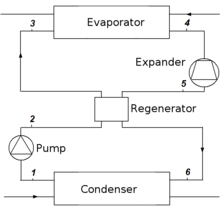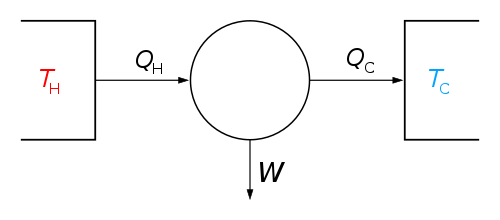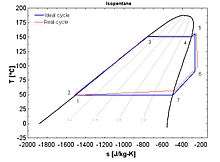Organic Rankine cycle
The Organic Rankine Cycle (ORC) is named for its use of an organic, high molecular mass fluid with a liquid-vapor phase change, or boiling point, occurring at a lower temperature than the water-steam phase change. The fluid allows Rankine cycle heat recovery from lower temperature sources such as biomass combustion, industrial waste heat, geothermal heat, solar ponds etc. The low-temperature heat is converted into useful work, that can itself be converted into electricity.

| Thermodynamics | ||||||||||||
|---|---|---|---|---|---|---|---|---|---|---|---|---|
 The classical Carnot heat engine | ||||||||||||
|
||||||||||||
| ||||||||||||
The technology was developed in the late 1950s by Lucien Bronicki and Harry Zvi Tabor.[1][2]
Naphtha engines, similar in principle to ORC but developed for other applications, were in use as early as the 1890s.
Working principle of the ORC

The working principle of the organic Rankine cycle is the same as that of the Rankine cycle: the working fluid is pumped to a boiler where it is evaporated, passed through an expansion device (turbine,[3] screw,[4] scroll,[5] or other expander), and then through a condenser heat exchanger where it is finally re-condensed.
In the ideal cycle described by the engine's theoretical model, the expansion is isentropic and the evaporation and condensation processes are isobaric.
In any real cycle, the presence of irreversibilities lowers the cycle efficiency. Those irreversibilities mainly occur:[6]
- During the expansion: Only a part of the energy recoverable from the pressure difference is transformed into useful work. The other part is converted into heat and is lost. The efficiency of the expander is defined by comparison with an isentropic expansion.
- In the heat exchangers: The working fluid takes a long and sinuous path which ensures good heat exchange but causes pressure drops that lower the amount of power recoverable from the cycle. Likewise, the temperature difference between the heat source/sink and the working fluid generates exergy destruction and reduces the cycle performance.
Improvement of the organic Rankine cycle
In the case of a "dry fluid", the cycle can be improved by the use of a regenerator: since the fluid has not reached the two-phase state at the end of the expansion, its temperature at this point is higher than the condensing temperature. This higher temperature fluid can be used to preheat the liquid before it enters the evaporator.
A counter-current heat exchanger (gas to liquid) is thus installed between the expander outlet and the condenser inlet. The power required from the heat source is therefore reduced and the efficiency is increased.
Applications for the ORC
| Part of a series about |
| Sustainable energy |
|---|
 |
| Overview |
| Energy conservation |
| Renewable energy |
| Sustainable transport |
|
| Part of a series on |
| Renewable energy |
|---|
 |
|
The organic Rankine cycle technology has many possible applications, and counts more than 2.7 GW of installed capacity and 698 identified power plants worldwide.[7] Among them, the most widespread and promising fields are the following:[8]
Waste heat recovery
Waste heat recovery is one of the most important development fields for the organic Rankine cycle (ORC). It can be applied to heat and power plants (for example a small scale cogeneration plant on a domestic water heater), or to industrial and farming processes such as organic products fermentation, hot exhausts from ovens or furnaces (e.g. lime and cement kilns), flue-gas condensation, exhaust gases from vehicles, intercooling of a compressor, condenser of a power cycle, etc.
Biomass power plant
Biomass is available all over the world and can be used for the production of electricity on small to medium size scaled power plants. The problem of high specific investment costs for machinery, such as steam boilers, are overcome due to the low working pressures in ORC power plants. Another advantage is the long operational life of the machine due to the characteristics of the working fluid, that unlike steam is non eroding and non corroding for valve seats tubing and turbine blades. The ORC process also helps to overcome the relatively small amount of input fuel available in many regions because an efficient ORC power plant is possible for smaller sized plants.
Geothermal plants
Geothermic heat sources vary in temperature from 50 to 350 °C. The ORC is therefore perfectly adapted for this kind of application. However, it is important to keep in mind that for low-temperature geothermal sources (typically less than 100 °C), the efficiency is very low and depends strongly on heat sink temperature (defined by the ambient temperature).
Solar thermal power
The organic Rankine cycle can be used in the solar parabolic trough technology in place of the usual steam Rankine cycle. The ORC allows power generation at lower capacities and with a lower collector temperature, and hence the possibility for low-cost, small scale decentralized CSP units.[9][10]
Choice of the working fluid
The selection of the working fluid is of key importance in low temperature Rankine Cycles. Because of the low temperature, heat transfer inefficiencies are highly prejudicial. These inefficiencies depend very strongly on the thermodynamic characteristics of the fluid and on the operating conditions.
In order to recover low-grade heat, the fluid generally has a lower boiling temperature than water. Refrigerants and hydrocarbons are two commonly used components.
Optimal characteristics of the working fluid :
- Isentropic saturation vapor curve :
Since the purpose of the ORC focuses on the recovery of low grade heat power, a superheated approach like the traditional Rankine cycle is not appropriate. Therefore, a small superheating at the exhaust of the evaporator will always be preferred, which disadvantages "wet" fluids (that are in two-phase state at the end of the expansion). In the case of dry fluids, a regenerator should be used.
- Low freezing point, high stability temperature :
Unlike water, organic fluids usually suffer chemical deteriorations and decomposition at high temperatures. The maximum hot source temperature is thus limited by the chemical stability of the working fluid. The freezing point should be lower than the lowest temperature in the cycle.
- High heat of vaporisation and density :
A fluid with a high latent heat and density will absorb more energy from the source in the evaporator and thus reduce the required flow rate, the size of the facility, and the pump consumption.
- Low environmental impact
The main parameters taken into account are the Ozone depletion potential (ODP) and the global warming potential (GWP).
- Safety
The fluid should be non-corrosive, non-flammable, and non-toxic. The ASHRAE safety classification of refrigerants can be used as an indicator of the fluid dangerousness level.
- Good availability and low cost
- Acceptable pressures
Examples of working fluids
Modeling ORC systems
Simulating ORC cycles requires a numerical solver in which the equations of mass and energy balance, heat transfer, pressure drops, mechanical losses, leakages, etc. are implemented. ORC models can be subdivided into two main types: steady-state and dynamic. Steady-state models are required both for design (or sizing) purpose, and for part-load simulation. Dynamic models, on the other hand, also account for energy and mass accumulation in the different components. They are particularly useful to implement and simulate control strategies, e.g. during transients or during start & Another key aspects of ORC modeling is the computation of the organic fluid thermodynamic properties. Simple equation of states (EOS) such as Peng–Robinson should be avoided since their accuracy is low. Multiparameter EOS should be preferred, using e.g. state-of-the-art thermophysical and transport properties databases.
Various tools are available for the above purposes, each presenting advantages and drawbacks. The most common ones are reported hereunder.
| Tool | Causality | Distribution | Examples available online | Description | |
|---|---|---|---|---|---|
| Steady-state Modeling tools: | |||||
| AxCYCLE Software Platform | Acausal | Non-free | Software Details | For the thermodynamic simulation and heat balance calculations of heat production and electric energy cycles, the AxCYCLE™ software platform allows users to design, analyze and optimize thermodynamic systems quickly and efficiently. | |
| ProSimPlus | / | Non-free | Software details | Easy to use software for steady-state simulation and optimization of processes that includes a complete thermodynamic package. | |
| Engineering Equation Solver | Acausal | Non-free | Simple ORC Model in EES | Popular equation-based solver that includes a database of fluid thermodynamic and transport properties. | |
| MATLAB | Causal | Non-free | High-level language and interactive environment for numerical computation, visualization, and programming | ||
| LMS Imagine.Lab Amesim | Causal
and Acausal |
Non-free | Graphical development environment and validated, packaged physical libraries for system simulation | ||
| GT-SUITE | Acausal | Non-free | Cummins Super Truck WHR | Complete multi-physics modeling environment designed for integrated system modeling | |
| Scilab | Acausal | Open-source | Simple ORC model | Open-source alternative to Matlab. | |
| Cycle-Tempo | Causal | Non-free | Tool for the thermodynamic analysis and optimization of systems for the production of electricity, heat and refrigeration | ||
| Dynamic modeling tools: | |||||
| Modelica | Acausal | Open-source | Dynamic model of a waste heat recovery system | Object-oriented, declarative, multi-domain modeling language for component-oriented modeling of complex systems | |
| Simulink | Causal | Non-free | A block diagram environment for multidomain simulation and Model-Based Design | ||
| GT-SUITE | Acausal | Non-free | Cummins Super Truck WHR | Complete multi-physics modeling environment designed for integrated system modeling | |
| LMS Imagine.Lab Amesim | Causal
and Acausal |
Non-free | Small Scale ORC Plant Modeling with the AMESim Simulation Tool [...] | Graphical development environment and validated, packaged physical libraries for system simulation | |
| Thermophysical and transport properties of organic fluids: | |||||
| Simulis Thermodynamics | / | Non-free | Software for mixture properties and fluid phase equilibria calculations. | ||
| CoolProp | / | Open-source | Cross-platform, free property database based in C++ that includes pure fluids, pseudo-pure fluids, and humid air properties. | ||
| Refprop | / | Non-free | Reference Fluid Thermodynamic and Transport Properties Database | ||
| FluidProp | / | Free | Software for the calculation of thermophysical properties of fluids | ||
| AspenProp | / | Non-free | Software for the calculation of thermophysical properties of fluids | ||
See also
- Rankine cycle
- Thermodynamic cycle
- Relative cost of electricity generated by different sources
- Naphtha launch
- Working fluids
References
- Harry Zvi Tabor, Cleveland Cutler, Encyclopedia of the Earth, 2007.
- Israeli Section of the International Solar Energy Society Archived 2009-01-11 at the Wayback Machine, edited by Gershon Grossman, Faculty of Mechanical Energy, Technion, Haifa; Final draft.
- Arifin, M.; Pasek, A. D. (2015). "Design of Radial Turbo-Expanders for Small Organic Rankine Cycle System". 7th International Conference on Cooling & Heating Technologies. 88 (88): 012037. Bibcode:2015MS&E...88a2037A. doi:10.1088/1757-899X/88/1/012037.
- Ziviani, Davide; Gusev, Sergei; Schuessler, Stefan; Achaichia, Abdennacer; Braun, James E.; Groll, Eckhard A.; Paepe, Michel De; van den Broek, Martijn (13 September 2017). "Employing a Single-Screw Expander in an Organic Rankine Cycle with Liquid Flooded Expansion and Internal Regeneration". Energy Procedia. 129: 379. doi:10.1016/j.egypro.2017.09.239.
- Galloni, E.; Fontana, G.; Staccone, S. (25 July 2015). "Design and experimental analysis of a mini ORC (organic Rankine cycle) power plant based on R245fa working fluid". Energy. 90: 768–775. doi:10.1016/j.energy.2015.07.104.
- Sustainable energy conversion through the use of Organic Rankine Cycles for waste heat recovery and solar applications (PDF) (Thesis). University of Liège, Liège, Belgium. 2011-10-04. Retrieved 2011-10-31.
- T. Tartiere. "ORC World Map". Retrieved 16 August 2016.
- Quoilin, Sylvain; Broek, Martijn Van Den; Declaye, Sébastien; Dewallef, Pierre; Lemort, Vincent (2013). "Techno-economic survey of Organic Rankine Cycle (ORC) systems" (PDF). Renewable and Sustainable Energy Reviews. 22: 168–186. doi:10.1016/j.rser.2013.01.028. Retrieved 2013-03-02.
- "Solar micro-generator". Stginternational.org. Archived from the original on 2013-03-03. Retrieved 2017-04-29.CS1 maint: BOT: original-url status unknown (link)
- "Power From the Sun :: Chapter 12.2 Rankine Power Cycles". Power From the Sun. Retrieved 2017-04-29.
- "TURBODEN - Organic Rankine Cycle systems" (PDF).